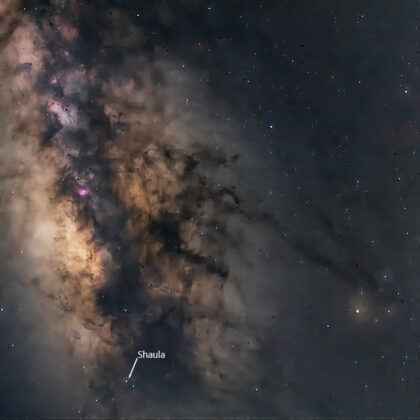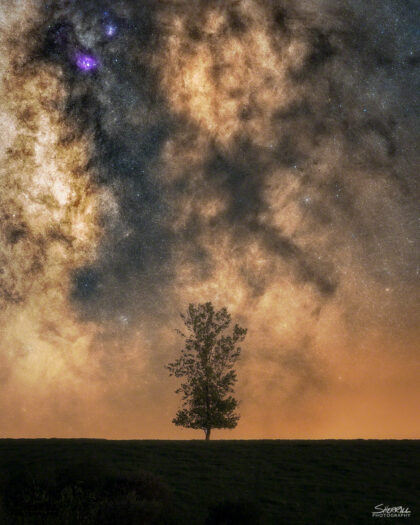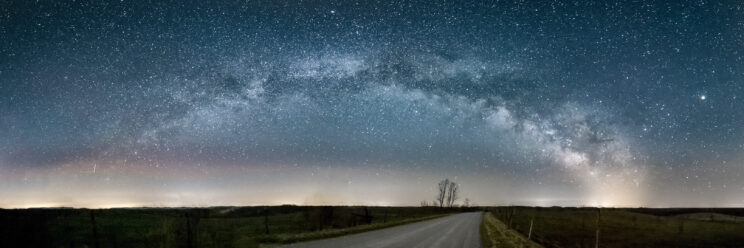Below is a link where you can download my free 2022 Ohio Milky Way Photography Calendar. It’s really more of a spreadsheet than a calendar though. Also, the days and moon phases are accurate no matter where you are in the United States. The times are calculated for Central Ohio, but will be accurate to within about 30 minutes no matter where you are in the United States. If you live north of central Ohio then the times will be earlier. If you live south then the times will be later. If your part of the country doesn’t do Daylight Savings Time then time accuracy goes out the window. On the plus side though, you don’t have to deal with stupid, useless Daylight Savings Time.
THE MOON
The nights of the new moons are the best for Milky Way photography. What’s a new moon? It’s when the moon is between the Earth and the Sun so the side that faces us is dark. Without the Moon reflecting sunlight in our night sky, it is as dark as it can get and we can see and photograph the stars. Being out around the new moon may also lessen your chances of encountering werewolves. That’s not a guarantee though.

 Because moon phases are so important to Milky Way photography, the calendar/spreadsheet is organized around each new moon instead of by month. Nights of the new moon are indicated by a black background. Dates with a dark blue background are also excellent; although the moon is not technically “new” on these nights, it is a tiny sliver and stays well below the horizon all night. On dates with a regular blue background it will be dark most of the night. Dates with a light blue background aren’t ideal for Milky Way photos, but the moon is still only partially illuminated and stays at or below the horizon most of the night. The dates with the lightest blue backgrounds are barely dark enough for long enough to get a Milky Way photo. These would be great nights to try combining the Milky Way with a moonlit landscape.
Because moon phases are so important to Milky Way photography, the calendar/spreadsheet is organized around each new moon instead of by month. Nights of the new moon are indicated by a black background. Dates with a dark blue background are also excellent; although the moon is not technically “new” on these nights, it is a tiny sliver and stays well below the horizon all night. On dates with a regular blue background it will be dark most of the night. Dates with a light blue background aren’t ideal for Milky Way photos, but the moon is still only partially illuminated and stays at or below the horizon most of the night. The dates with the lightest blue backgrounds are barely dark enough for long enough to get a Milky Way photo. These would be great nights to try combining the Milky Way with a moonlit landscape.
Useless trivia side note: In April, 2022 we will have a “Black Moon” which is a second new moon in the same month. Oooooh.
THE DARK
While we definitely need a moonless or nearly moonless night for Milky Way photography, we also really need the the sun to not be in the sky. So can we start shooting at sunset then? Oh no! For Milky Way photos the vague notion of “dark” will not do. We need “Astro Dark”! What’s Astro Dark? Well the sun is so annoyingly shiny that it has to be far below the horizon (18 degrees below to be nerdy about it) before it stops screwing up our night sky. Astro dark is the time the sky is as dark as it gets and usually begins about 90 minutes after sunset and ends about 90 minutes before sunrise
THE CORE
 What most people want to capture when they photograph the Milky Way is the colorful, dramatic core of our galaxy.
What most people want to capture when they photograph the Milky Way is the colorful, dramatic core of our galaxy.
In the northern hemisphere the core is only visible above the horizon during those astro dark times for about nine months out of the year. But what counts as the “core”? It’s a little subjective, but for the sake of the calendar, I’ve chosen the star Shaula, the last star in the tail of the constellation Scorpius, as the lower boundary of the core. So the Milky Way rise and set times are based on when Shaula crosses the horizon.
 But be aware that because our views of the horizon are seldom perfect, Shaula may be hidden by light glow or trees, hills, or buildings (but probably not werewolves) while you’re taking your photos.Of course these times are approximate and vary with your elevation and location. If you’re on a tall hill with a clear view or on the shore of an ocean or large lake, you’ll be able to see more of the core for longer.
But be aware that because our views of the horizon are seldom perfect, Shaula may be hidden by light glow or trees, hills, or buildings (but probably not werewolves) while you’re taking your photos.Of course these times are approximate and vary with your elevation and location. If you’re on a tall hill with a clear view or on the shore of an ocean or large lake, you’ll be able to see more of the core for longer.
And you can take Milky Way photos before and after Shaula crosses the horizon. Don’t think of these times as cast in stone; they’re only a general guide.
THE SESSION
So these three factors, the Moon, astro dark, and Milky Way rise and set times determine when and for how long you can most effectively photograph the Milky Way. The three columns on the left give the date and session start and end times. The remaining columns give you the duration, the rise/start and end/set times for the moon, astro dark, and the core, and indicate which determines the start and end time of the session with either a red or green background.
THE DOWNLOAD
Click the button below (and choose Save File if an option box appears) to download the calendar as a PDF. Feel free to print the calendar for your own use and share the PDF file with anyone, but don’t be an asshole and try to take credit for it or try to sell it. Happy shooting and clear skies!
THE FUTURE
If the pandemic is under control by next spring, I am planning on offering Milky Way Photography Workshops. You can use the contact form below to send me an email if you’re interested in receiving updates about the workshops.
Ohio weather makes scheduling Milky Way sessions far in advance nearly impossible, so the workshops will be in three parts. First will be a daytime session where we will go over gear, technique, and settings. Second, when a clear moonless night is available, we’ll have a meetup of up to six students and practice shooting the Milky Way. Third will be a session in person or over Zoom where you will learn how to process your Milky Way photos in Lightroom and Photoshop.
The plan is to offer three levels of workshops: Beginner, Intermediate, and Advanced. Beginners will learn how to take and process a single frame Milky Way photo. Intermediate students will learn how to take, stack, and composite multiple exposures for cleaner and more vibrant photos. Advanced students will learn how to use a star tracker to take, stack, and composite multiple very long exposures to create exceptional Milky Way photos and panoramas.
